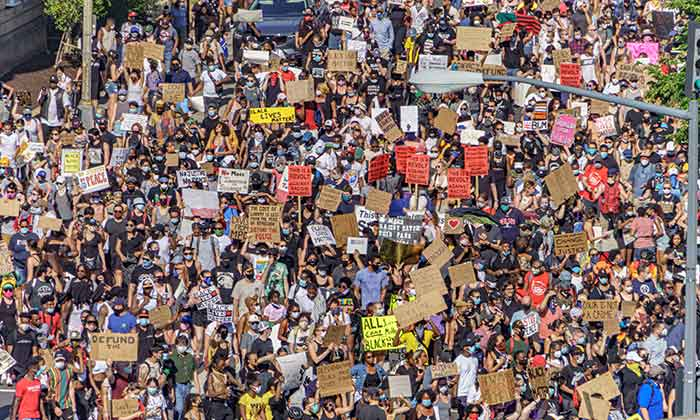
The India that we inhabit today, the India that we inherited from our ancestors, the India that we pledge our patriotic loyalty to; was built on the dissent of her people. Dissent against an oppressive Colonial regime, dissent against oppressive structures of Caste, dissent against acts of political aggression by ruling governments, and dissent against arbitrary and unfair legislations passed. The very history of the Nationalist movement in India is an ode to the tradition of protest, more specifically the non-violent protest. The legacies of Gandhi’s Satyagraha have inspired and continue to inspire protest movements both domestically and globally. From Martin Luther King Jr. advocating for Civil rights for the African-American community in the United States of America to Nelson Mandela campaigning against Apartheid and colonial occupation in South Africa, Gandhian philosophy is credited to have guided leaders and peoples towards political and social liberation combined with the search for truth and self-realisation.
Thus Gandhi’s relevance in contemporary times isn’t just limited to currency notes or abstract references to culture, freedom, and peace. His relevance is found in the everyday actions of protest of individuals and civic groups. Indeed, the Constitution of India formally guarantees every citizen the Right to Protest under article 19(1)(b) of the Fundamental Rights, albeit with an important caveat of the reasonable restriction of peace. But if we were to put this reasonability test under a microscope today, the results would surely be interesting. More notably, they will probably leave us with more questions than answers. What would peace in a protest mean? Is peaceful protest the only ‘valid’ way of dissent? Does it delegitimize any other forms of protest? What implication does it have on the claims of the protesting people and communities?

In a year when the nation witnessed two of the most widespread popular protests in recent history- namely the Anti-Citizenship Amendment Act protests and the Anti-Farmer’s Bills protests, the vocabulary of protest found its way in everyday conversations of the citizen and the politician alike. And nowhere was the impact felt as emphatically as in the capital city of Delhi. What was notable was the perception of the protest and the protestors in the eyes of the public, exacerbated by media narratives of the same. A significant portion of the population saw these protests as an inconvenience. Any act of violence emanating from these was honed in and exaggerated to dismiss the legitimacy of the protest itself, making us wonder- is damage to public property or something as visceral and hazardous to life as the burning of buses acceptable in the name of protest? Probably not. But more importantly, does it delegitimize the protestor’s cause? Arguably no. Questions about paid-for protestors, political goons and public delinquents in the protest crowd further muddy the waters, making this an extremely difficult terrain to navigate. A stark example of this was the backlash and outrage that was met out to the Farmer’s protests in light of the infamous Republic Day incident. Protesting farmers were viewed as too hostile, too violent, too disruptive, too disrespectful of the Indian flag and its legacy, and too dismissive of the social and cultural importance of the National holiday. Accusations of anti-national and treason were quick to fly and there was no demarcation between the protestor’s cause and his action.

This sentimental aversion to violence is perhaps one of the most remarkable remnants of the Gandhian peace that had willingly called off the Non-Cooperation movement at its height due to an isolated incident of violence at Chauri Chaura. However, what one tends to forget is that the everyday citizen is a human, a human in possession of volatile human emotions of anger, rage, and fury. Is it then not unfair to hold him up to generalised standards of the self-actualised peace-loving Mahatma?
More so, the hypocrisy of this crowd is especially notable. This reverence of Satyagraha to invalidate the claims of protesting groups is in stark opposition to the resentment of Gandhi within these circles. A resentment that stems from his role in establishing India as a secular nation post-Partition. The hypocrisy that valorizes and justifies the use of necessary force but to serve no other purpose than that of its own ideology. Thus this veneration of Gandhi is as superficial, performative, and utilitarian as their promises of tolerance.

The protest then becomes political not just for the cause it campaigns for, but also the means it employs. Walking the tightrope between the ‘desired’ and ‘accepted’ forms of protest and the ‘revolutionary’ acts of protest thus becomes an important dilemma for the modern-day activist in India. The activist has to make calculated calls for actions while also evading the clutches of being labeled a propagandist. He has to ensure that the protest is organic enough to be viewed as authentic but also organised enough to not be an ‘inconvenience’. Juggling this balancing act sure seems like a lot to expect from a group merely performing its democratic civil rights but it nonetheless seems like the only recourse available. Leaving us with the uncomfortable question of- Is the protest narrative of today quite simply designed for failure?

